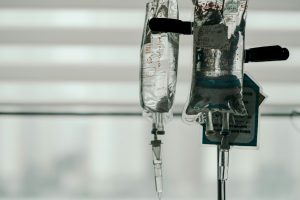Not all pain is created equal. Depending on its source, severity, and circumstance, different types of pain require different treatments. In this series, we here at WEX will discuss different causes of pain and how they have been treated. Here, we will be discussing Chemotherapy-Induced Neuropathic Pain, or CINP.

Chemotherapy is one of the most widely used treatments for cancer. While it has saved countless lives, many who have had to endure chemotherapy can attest to the plethora of side effects that come with the treatment, including nausea, gastrointestinal issues, and hair loss. One particularly distressing side effect is chemotherapy-induced neuropathic pain, or CINP, which can significantly affect a chemotherapy patient’s quality of life, and their ability to complete their prescribed chemotherapy program.[1] In this article, we will delve into what CINP is, its causes, symptoms, and strategies for managing and alleviating this challenging condition.
Understanding Chemotherapy-Induced Neuropathic Pain
CINP is a type of chronic pain that results from damage to the peripheral nerves caused by neurotoxic antitumor agents used in chemotherapy. These agents (most commonly taxanes, platinum-based drugs, vinca alkaloids, proteasome inhibitors, or thalidomide)[2] cause damage to the peripheral nerves, resulting in numbness, tingling, and pain. This pain is usually located in the extremities such as the fingers and toes, but can progress to the legs, arms, and face. In addition, patients have reported feeling muscle weakness, cramping, dizziness, and hearing-related issues. The umbrella term for the complications caused by these agents is Chemotherapy-Induced Peripheral Neuropathy, or CIPN.
What makes CINP so hard to treat
CINP can be a difficult condition to treat. For one, there is no conclusive biological marker for CINP. While some diagnostic tools like an Electromyography (EMG) test may be helpful in confirming a clinical assessment, patient reporting of symptoms is still heavily relied upon for CINP diagnosis.[3] For patients who do not know about CINP, this means that their suffering can be prolonged. The incidence of CINP for chemotherapy patients is high, and if left untreated, it can turn into a long-term condition, with patients suffering from it for years after chemotherapy has ceased.[4] Even more alarming, some patients report such intense pain under CINP that they make the choice to reduce their chemotherapy treatments, and many others stop treatment altogether.[5] This highlights how demoralizing CINP can be for people living with cancer, as the medicine that is meant to treat their cancer is causing them undue pain, increasing their psychological and emotional stress.

It may seem like an arduous endeavour, but here are some of the current ways CINP is managed today:
SSRIs: Duloxetine
Currently, Duloxetine is the only medication endorsed by the American Society of Clinical Oncology for treatment of CINP. A selective serotonin reuptake inhibitor (SSRI),double-blind study to reduce incidence of CINP greater than placebo, though the FDA has not approved the treatment for this condition.[6]
Anticonvulsants and Other Medications
Other than Duloxetine, there have been other drugs that medical professionals have prescribed for CINP. These include a variety of opioids, NSAIDs, and anticonvulsants like Pregabalin and Gabapentin.[7] These treatments have shown varying degrees of success, but so far have not been able to demonstrate proven efficacy in clinical trials conducted to date, and there does not seem to be a consensus on a treatment approach.

Topical/Non-Oral Treatments
Outside of oral medications, menthol cream and capsaicin patches have shown some success in managing CINP. Some CINP patients have even found success treating their condition with non-pharmacological treatments such as acupuncture, physical therapy, and regular exercise.[8] However, like with the differing oral medications, there is a lack of consensus on what steps CINP patients can take to ensure their pain is reduced.
Chemotherapy-induced neuropathic pain is a challenging and distressing side effect of cancer treatment. People suffering from cancer whilst also experiencing CINP can be a debilitating set of circumstances. While pharmacological solutions to this problem are still being developed, it is crucial for people living with CINP to understand that they need not suffer alone. Discussing these symptoms with medical professionals is the first step to managing CINP. This can help chart the best course of action, whether through medications, physical therapy, or lifestyle changes. With proper care, support, and a combination of medical and alternative therapies, patients can better cope with the pain and discomfort associated with CINP while continuing their fight against cancer.
[1] Knoerl, R. (2021). CE: Chemotherapy-induced peripheral neuropathy. AJN, American Journal of Nursing, 121(4), 26–30. https://doi.org/10.1097/01.naj.0000742060.56042.e7
[2] Ibid.
[3] Jordan, B., Margulies, A., Cardoso, F., Cavaletti, G., Haugnes, H. S., Jahn, P., Le Rhun, E., Preusser, M., Scotté, F., Taphoorn, M. J. B., & Jordan, K. (2020). Systemic Anticancer Therapy-induced Peripheral and Central Neurotoxicity: ESMO–eons–EANO Clinical Practice Guidelines for Diagnosis, Prevention, Treatment and Follow-up. Annals of Oncology, 31(10), 1306–1319. https://doi.org/10.1016/j.annonc.2020.07.003
[4] Colvin, L. A. (2019). Chemotherapy-Induced Peripheral Neuropathy: Where Are We Now? Pain, 160(1). https://doi.org/10.1097/j.pain.0000000000001540
[5] Ibid.
[6] Ibid.
[7] Maihöfner, C., Diel, I., Tesch, H., Quandel, T., & Baron, R. (2021). Chemotherapy-Induced Peripheral Neuropathy (CIPN): Current Therapies and Topical Treatment Option with High-Concentration Capsaicin. Supportive Care in Cancer, 29(8), 4223–4238. https://doi.org/10.1007/s00520-021-06042-x
[8] Jordan et al., Systemic Anticancer Therapy, 1306–1319.